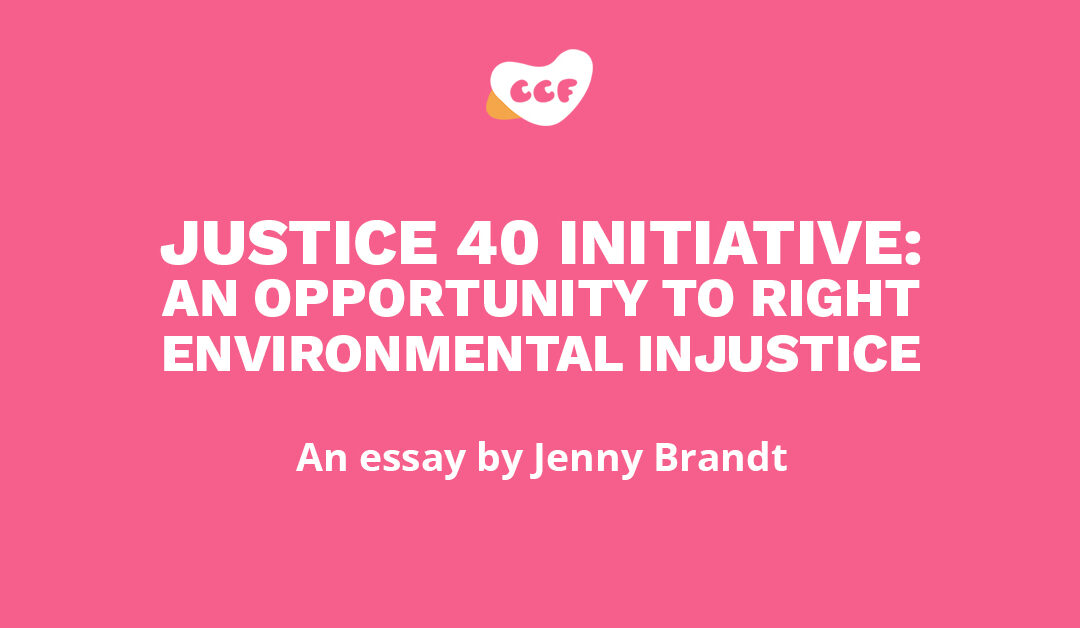By Jenny Brandt, member of CCF Global Council and co-lead of membership team
We have an opportunity to address long-standing environmental injustices and redistribute wealth back into communities it has been taken from.
With the passage of Executive Order 14008, which created the Justice 40 initiative, we are in a time of unprecedented funding available for environmental justice communities.
The US government has not always invested in Black, Indigenous, and people of color (BIPOC) communities. And some historical investments have gone a long way to harm these communities (i.e., building highways and airports that displace Black and Brown communities and increase pollution and noise levels; siting toxic waste disposal facilities, including landfills and incinerators, in marginalized communities; the development and operation of fossil fuel infrastructure, such as pipelines, refineries, and extraction sites, leading to environmental degradation, health problems, and economic disparities in these communities, just to name a few).
It is important that our CCF network, especially the BIPOC fundraisers, have access to information about the avenues for accessing that funding to improve the lives of BIPOC communities.
The specifics of the Justice 40 Initiative
Three years ago, President Biden signed Executive Order 14008, “Tackling the Climate Crisis at Home and Abroad,” creating the Justice 40 Initiative. This initiative seeks to change the amount of investment that would flow to communities that were not usually considered a priority to receive Federal investments. The new goal is that 40% of the overall benefits of certain Federal investments will go to disadvantaged communities that are marginalized, underserved, and overburdened by pollution.
For reasons related to the possibility of this being struck down in court, these communities are not referred to by race, though the fact that most of these are BIPOC communities is no coincidence.
The funding focuses on investments set to address climate change, clean energy and energy efficiency, clean transit, affordable and sustainable housing, training and workforce development, remediation and reduction of legacy pollution, and the development of critical clean water and wastewater infrastructure.
The order did not create a fund in and of itself, instead, the funds come from existing Federal programs and new programs created under the Inflation Reduction Act, Bipartisan Infrastructure Law, and the American Rescue Plan.
Accessing funds and how to learn more
The government created a Climate and Economic Justice Screening Tool (CJEST), which today looks like this map. It can tell you the burdens that your community faces and if your community could be eligible to receive funding. All communities on land within the boundaries of Federally Recognized Tribes are eligible.
Additionally, if your community is at or above the 90th percentile in one or more environmental, climate, or other burdens, and at or above the 65th percentile for low income, it would be eligible.
As an example, I used this map to look up my old neighborhood in Queen’s Chapel in Washington, DC. The census tract it falls in is above the 90th percentile for people who have been told they have asthma, for lead paint in homes, for the count of hazardous waste facilities within 5 km, for underground storage tanks and releases but below the 65th percentile for low income, so my community is not eligible to apply for funds to clean up legacy pollution, housing, or health. But our unemployment is above the 90th percentile, and the percent of people ages 25 years or older whose high school education is less than a high school diploma is above 10%, making my community eligible for workforce development funding. (Methodology).
This information will be most useful to groups already doing workforce development in the area, or a group of concerned community members can get together and find partners to submit a proposal to receive such funding. If you need additional support in connecting with potential partners in local government, or groups with experience attaining these funds, you can look for it from your regional Environmental Justice Thriving Communities Technical Assistance Center (EJ TCTAC).
The Environmental Protection Agency and the Department of Energy have funded 16 EJ TCTACs around the country that will receive $177 million to help underserved and overburdened communities across the country. In the table below are the EJ TCTACs, which state, territory, or area they cover, and how to find out more:
|
Region 1 (serving CT, ME, MA, NH, RI, and VT) |
Institute for Sustainable Communities is a national EJ TCTAC that will serve Region 1 until a Region 1-focused EJ TCTAC is selected, expected in early 2024. | region1tctacinquiries@sustain.org |
|
Region 2 (serving NJ, NY, Puerto Rico, the U.S. Virgin Islands, and 8 federally recognized Indian Nations) |
West Harlem Environmental Action, Inc. (dba WE ACT for Environmental Justice) | https://www.weact.org/tctac/ |
|
Region 2 (serving NJ, NY, Puerto Rico, the U.S. Virgin Islands, and 8 federally recognized Indian Nations) |
Inter-American University of Puerto Rico-Metropolitan Campus | https://metro.inter.edu/ecoeagle/ |
|
Region 3 (serving DE, DC, MD, PA, VA, WV, and 7 federally recognized tribes) |
National Wildlife Federation | https://www.nwf.org/Our-Work/Environmental-Justice/Region-3-TCTAC |
|
Region 4 (serving AL, FL, GA, KY, MS, NC, SC, and TN) |
Research Triangle Institute (RTI International) | http://react4ej.org/ |
|
Region 4 (serving AL, FL, GA, KY, MS, NC, SC, and TN) |
Deep South Center for Environmental Justice (DSCEJ) | https://www.dscej.org/circ |
|
Region 5 (serving IL, IN, MI, MN, OH, and WI) |
Blacks in Green (BIG) | Google Form |
|
Region 5 (serving IL, IN, MI, MN, OH, and WI) |
University of Minnesota | https://greatlakestctac.umn.edu/ |
|
Region 6 (serving AR, LA, NM, OK, and TX) |
New Mexico State University | https://scejrc.nmsu.edu/index.html |
|
Region 7 (serving IA, KS, MO, and NE) |
Wichita State University | https://heartlandej.org/ |
|
Region 8 (serving CO, MT, ND, SD, UT, and WY) |
International City/County Management Association | https://form.jotform.com/233324021161136 |
|
Region 9 (serving AZ, CA, HI, NV, American Samoa, Commonwealth of the Northern Mariana Islands, Federated States of Micronesia, Guam, Marshall Islands, and Republic of Palau) |
University of Arizona | https://westejcenter.arizona.edu/ |
|
Region 9 (serving AZ, CA, HI, NV, American Samoa, Commonwealth of the Northern Mariana Islands, Federated States of Micronesia, Guam, Marshall Islands, and Republic of Palau) |
San Diego State University | Center for Community Energy and Environmental Justice (CCEEJ) |
|
Region 10 (serving AK, ID, OR, WA, and 271 native tribes) |
Willamette Partnership | https://willamettepartnership.org/ej-tctac/ |
|
Region 10 (serving AK, ID, OR, WA, and 271 native tribes) |
University of Washington | https://deohs.washington.edu/cehe/ |
Additional resources provided on the White House Justice 40 website.
Agencies that have released their covered programs under the Justice 40 Initiative include:
- Army Corps of Engineers
- Corporation for National and Community Service / AmeriCorps
- Department of Agriculture
- Department of Energy
- Department of Homeland Security/Federal Emergency Management Agency
- Department of Housing and Urban Development
- Department of the Interior
- Department of Health and Human Services
- Department of Labor
- Department of Transportation
- Department of Veteran Affairs
- Environmental Protection Agency
- Appalachian Regional Commission
- Delta Regional Authority
- Denali Commission
Early successes of the Justice 40 Initiative
The Justice 40 Accelerator page shares just a few examples of their Justice 40 success stories:
In Chicago, it helped Blacks in Green fund their effort to build a community-directed lead-free water project focused on education, testing, and increasing access to in-home filtration systems.
In Hamilton, it supported the West Georgia Farmers Cooperative in advancing food security by providing funding for a community-owned grocery store, commercial kitchen, and credit union, empowering local farmers, producers, and culinary entrepreneurs to expand their local businesses.
In Stockton, it assisted Little Manila Rising in facilitating a just energy transition for their community via the Department of Energy’s LEAP program. Through the acquisition of $500,000 in public funding, they are addressing longstanding energy and pollution challenges to establish a clean, dependable, fair, and secure electricity system that benefits the Little Manila community.
This is an important opportunity for the communities who have been the most historically disadvantaged to receive access to funding to improve outcomes in health, climate change preparedness, transportation connectivity and so on. We’re already seeing innovative projects improving lives in these three examples. Please share this potentially life-changing financial opportunity with the communities in your network who need it most. We have an opportunity to address long-standing environmental injustices and redistribute wealth back into communities it has been taken from.

Jenny Brandt
Jenny Brandt (she/her) is a member of the Global Council at CCF. She is a co-lead of the Membership and Regional team and is building the network in Latin America.
Her career in non-profit organizations has focused on building equitable access for Latino communities to health, economic justice, advocacy, jobs within the Federal government, environmental justice, resources and conservation.
She currently resides in Chetumal, Mexico where she loves taking photographs. You can find her on Linkedin here.
Discover more from CCF
Subscribe to get the latest posts sent to your email.

